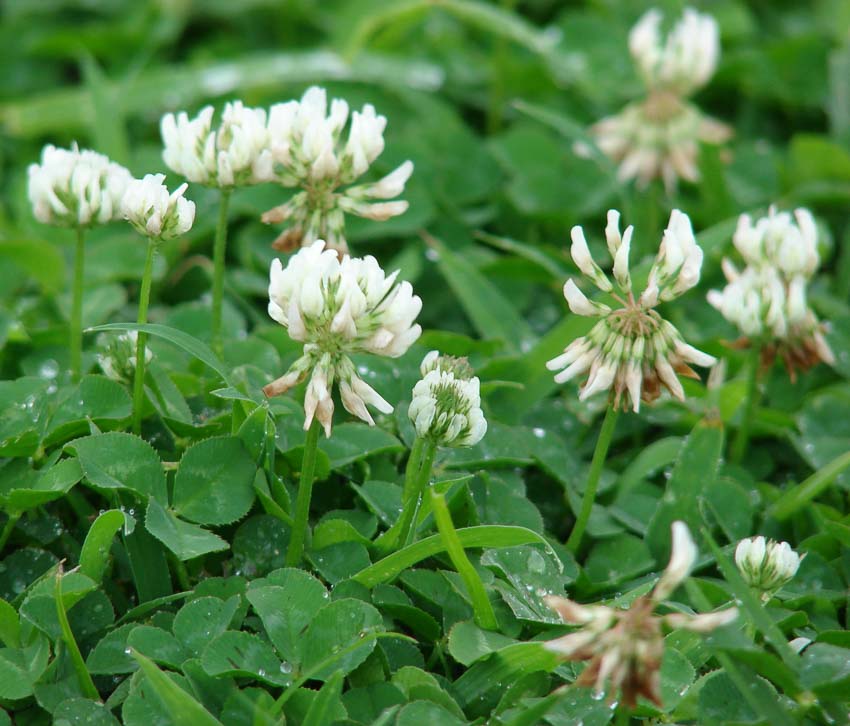The leaves of Dutch White clover are an iconic symbol of luck and fortune. People recognize it worldwide, but there’s even more magic to discover about the benefits of this treasured gem. Learn all about the history and cultivation of white clover and ways you can use it in your garden.
Understanding the History and Origin of Dutch White Clover
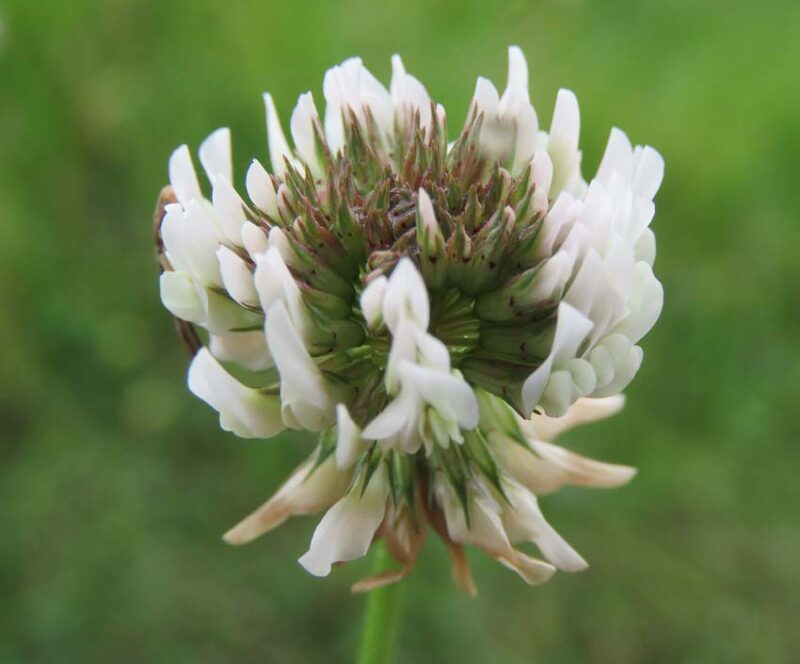
Clover has been intertwined with religion and superstition throughout history. From the medicinal uses of Pennsylvania Dutch settlers to the legends of the Celts, clover has been chronicled as an important plant in cultures worldwide.
Ancient Roots and Modern Spread
One of the most interesting facts about Dutch white clover is that its leaves are more popular than its flowers. Ancient cultures believed that white clover leaves could ward off bad luck and misfortune, perhaps because they used it medicinally for various illnesses and diseases.
Dutch White Clover in Folklore and Symbolism
The magic of the number three and the symbolism of the clover are closely connected. In folklore and religions, three-leaf clovers symbolize the number three’s integration, completeness, and perfection.
In the Middle Ages, people believed that four-leaf clovers carried special magical powers, and to this day, four-leaf clovers have spiritual significance for many people.
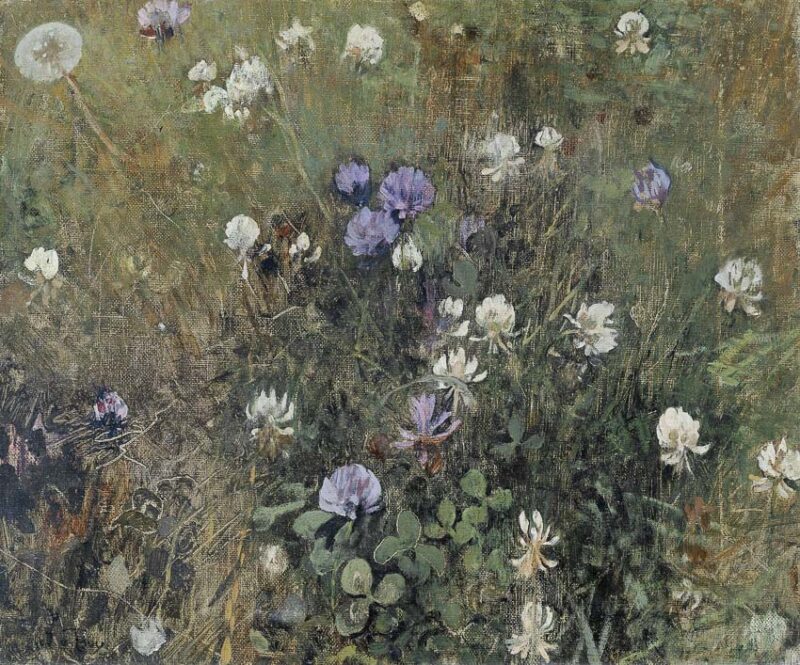
They are a rare anomaly of Trifolium repens, occurring in about one out of every 5,000 leaves. According to Irish legend, the five-leaf clover is another occasional mutation that brings even more luck and financial gain.
Physical Characteristics and Identifying Dutch White Clover
You can easily identify white Dutch clover. Learn how to identify it and distinguish it from its close relatives.
Recognizing the Plant
Dutch white clover is a low-growing, creeping plant with bright green leaves composed of three leaflets. It produces inflorescences of small, ball-shaped white to pink flowers from May through September and grows up to 10” tall.
The Lifecycle of Dutch White Clover
White clover has a lifespan of about three to five years.
An invasive plant, it reseeds itself easily and spreads by way of stolons. It grows in USDA hardiness zones 4 to 9. In the southern United States, people usually grow it annually during the winter because drought and disease weaken it in hot weather.
It will tolerate temperatures down to -35°F (-37°C) in northern climates.
Other Types of Clover
There are 255 species of clover in the Trifolium genus. Of those, there are a few well-known species.
Alsike clover–This perennial clover has blossoms similar to white clover but with more pink. It grows one to three feet tall, making it more suited as a forage crop than a grass alternative for lawns.
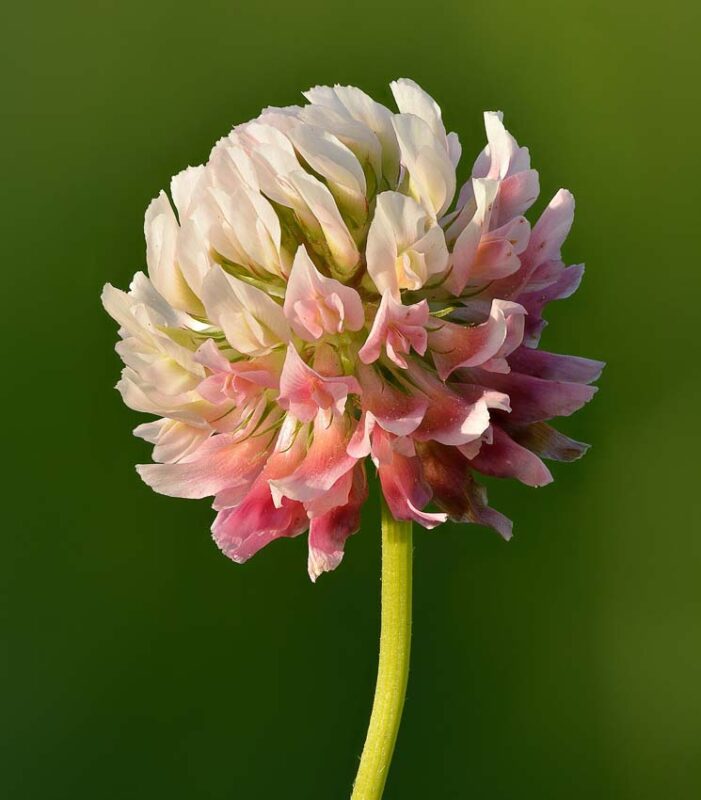
Red clover–At 6” to 24” with bright pink inflorescences, people commonly grow red clover in pasture mixes and for erosion control. Naturalized in meadows and grasslands, you won’t see it used as a cover crop as often as white clover because it is more aggressive.
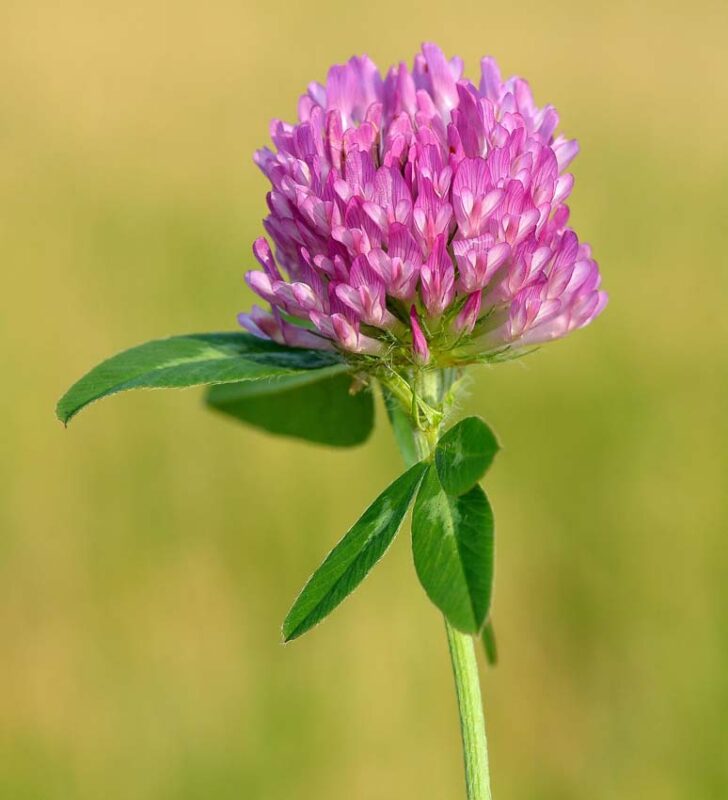
Microclover–A smaller Dutch white clover cultivar, microclover has fewer leaves and fewer flowers. It’s not as shade, heat, and drought tolerant as White Dutch clover, but it’s often chosen for lawns because it only gets 4” to 6” tall.
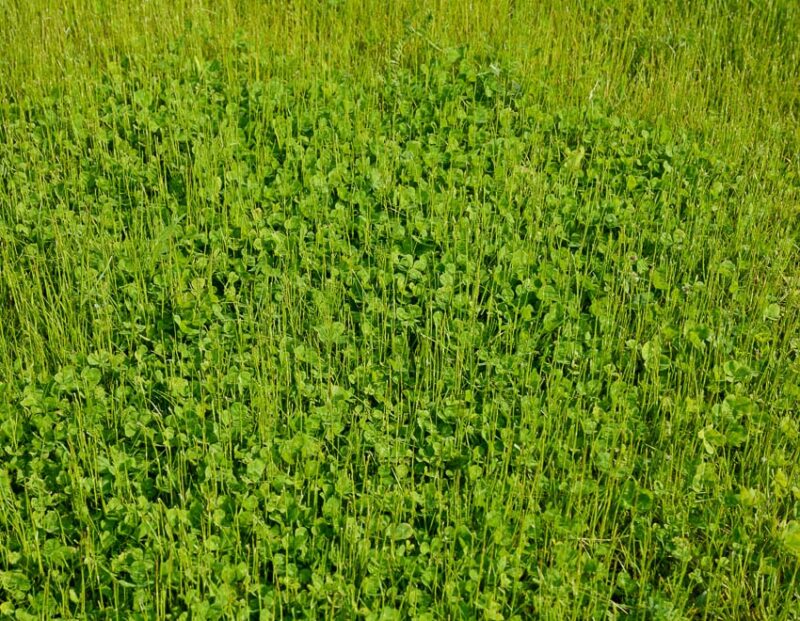
Why Choose Dutch White Clover? Understanding Its Benefits
For many reasons, growers widely use Dutch white clover on farms and in gardens. Learn more about the agricultural and ecological uses of this beneficial plant.
Agricultural Uses and Benefits
Once you understand the benefits of white Dutch clover, it’s no surprise that early European settlers brought clover to the New World. As a nitrogen-fixing plant, white clover greatly benefits soils and helps maintain sustainable agricultural practices.
White Clover is a Nitrogen Fixer
White clover is a legume, and almost all legumes are nitrogen fixers. What do nitrogen-fixing plants do, and how do they fix nitrogen?
Nitrogen comprises about 78% of the Earth’s atmosphere, but it’s in a gaseous form that’s not readily available to plants. Plants can only absorb nitrogen in the soil in the form of nitrates, nitrites, and urea.
Nitrogen-fixing plants have a symbiotic relationship with Rhizobia bacteria. These bacteria form nodules on the roots of legumes and use nitrogenase enzymes to process atmospheric nitrogen and convert it into a form of nitrogen that plants use.
When nitrogen-fixing plants die, they release available nitrogen into the soil, making it accessible to other plants. Nitrogen is a primary nutrient required for photosynthesis and plant growth, and farmers grow cover crops like alfalfa, vetch, and clover as “green manure.”
Uses for Clover in Agriculture
In addition to being used as a nitrogen-fixing cover crop, clover has many other agricultural uses.
- Dutch white clover is a good supplementary pollen source for bees, which are essential in crop production.
- White clover is an important forage crop for pasturing, hay production, and making silage for cattle, sheep, and other livestock.
- As a cover crop, white clover prevents erosion by reducing the effects of topsoil depletion.
- White clover can break up hard, compacted soils.
- You can use it as a living mulch between rows in large crop fields and gardens.
Ecological Advantages of White Clover
In most respects, Dutch white clover is good for the environment. Whether you’re growing it as an alternative to a grass lawn or using it as a cover crop, there are ecological advantages to growing white clover.
Weed Suppression
Since white clover is resilient, it can suppress the growth of other weeds. Its ability to suppress weeds makes it valuable as a cover crop and an excellent companion for grass in your lawn. Instead of relying on herbicides, you can save time and money by planting clover with your grass.
Reduced Environmental Impact
Traditional grass lawns have an enormous environmental impact. White Dutch clover lawns require less fertilizing, watering, and mowing than grass lawns, making them more ecologically friendly.
Farmers, homeowners, and avid gardeners use over a billion pounds of pesticides in the United States each year, of which about 80 million pounds go on lawns. In addition, homeowners in the United States use 3 trillion gallons of water on lawns each year and consume about 200 million gallons of gas to maintain lawns.
Attract Wildlife and Beneficial Pollinators
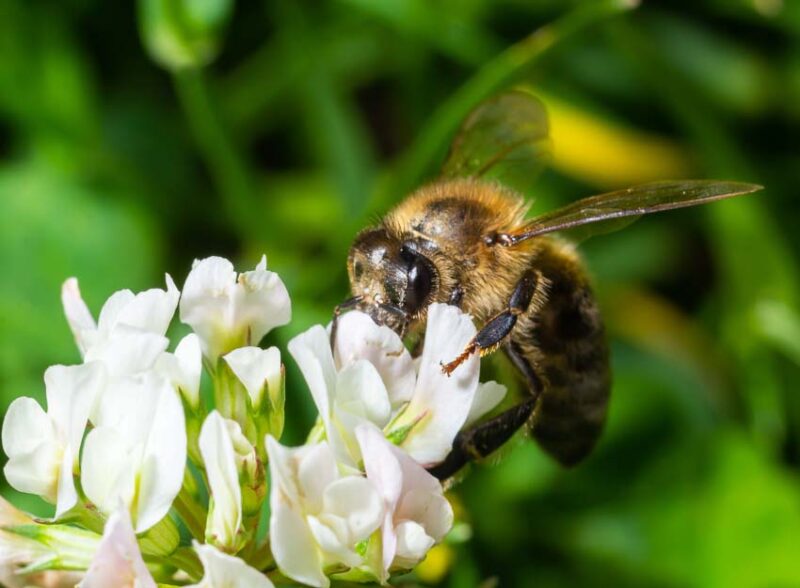
If you want to see more wildlife in your backyard, plant clover in your lawn and use it as a living mulch and cover crop to create a biodiverse ecosystem. Clover is high in nutrients, attracting deer, rabbits, and squirrels.
The more diverse the ecology in your backyard, the more wildlife species you will attract. With prey to feed on, you can attract raptors like owls and hawks and predators like foxes, bobcats, and coyotes.
You’ll also have more birds and insects in your yard. Clover flowers attract beneficial pollinators like honey bees, bumble bees, butterflies, and songbirds. What’s more, quail, turkeys, and grouse eat Dutch white clover as well.
Cultivation: How to Grow and Care for Dutch White Clover
Dutch white clover is surprisingly easy to grow. It requires little care and less frequent watering than grass, tolerating a wide range of soil types and varying amounts of light.
Ideal Conditions for Growth
You can mix Dutch white clover with grass to make it more tolerant of foot traffic, and it does well under the same conditions as lawn grass. White clover grows fast during cool, moist weather, but once it gets warm, it slows down.
The ideal soil pH for white clover is between 6.0 and 7.0, and it likes well-drained, fertile soils. You can plant it in early spring or fall and seed it directly on the ground without tilling. The best time to plant Dutch white clover seeds is when soil temperatures are 50°F to 60°F (10°C to 16°C), but they will germinate at temperatures around 40°F (4°C).
Common Challenges and Solutions
Growers rarely plant white Dutch clover alone as a forage crop because it doesn’t get tall enough. As a lawn alternative, it gets trampled easily, but it’s an excellent companion plant with other types of clover and grass.
Dutch white clover is invasive in some areas, spreading by seed and stolons. If you’re using it as a living mulch between crop rows, till it in when it starts creeping into your garden beds.
People who are allergic to bees may want to avoid planting clover in their lawns, as the flowers attract many pollinators. White clover is susceptible to pests and diseases in some areas, but these can be easily managed with chemicals.
Practical Uses of Dutch White Clover: Beyond the Soil
Most people grow Dutch white clover because it is an important pasture legume and cover crop, but other practical uses make it a great choice for anyone to include in their yard and garden.
Dutch White Clover in Landscaping
Dutch white clover has been growing in popularity as a grass alternative for lawns. It provides all the same benefits as grass but requires significantly less water and maintenance. Most grass lawns must be mowed at least once weekly, and white clover only requires a few mowings per year, making it a low-maintenance landscaping choice.
Unexpected Uses of White Dutch Clover, From Medicine to Crafts
People worldwide have long used Dutch white clover as medicine. They also use it in herbal teas and as poultices. You can even smoke it as an alternative to tobacco.
The most common medicinal uses of white clover include the following remedies:
- Boost the immune system
- Treat the common cold
- Relieve arthritis and joint pain
- Purify and cleanse the blood
You can also use it in a variety of arts and crafts projects. Dried clover flowers are a great addition to homemade potpourri, and you can find many ways to use the four-leaf clovers. Press four-leaf clovers in a book and wait two to three days, then use them in the following ways:
- As embellishments on cards, floral arrangements, and scrapbook projects.
- Embed four-leaf clovers in resin for jewelry, keychains, and good luck charms.
- Display four-leaf clovers in a glass or acrylic picture frame.
- Make a lucky bookmark using self-adhesive contact paper or laminate sheets.
- Make four-leaf clover refrigerator magnets with Mod Podge and bottle caps.
Once you start using pressed four-leaf clovers, you’ll find other ways, and as lucky charms, they make great gifts and party favors for any occasion.
Dutch White Clover FAQs
Is Dutch White Clover Invasive?
White Dutch clover is not native to North America. Early European settlers brought it to the United States, however, it is an invasive species.
Invasive plants are non-native plants that cause harm to the environment, economy, or humans.
Can Dutch White Clover Survive Winter?
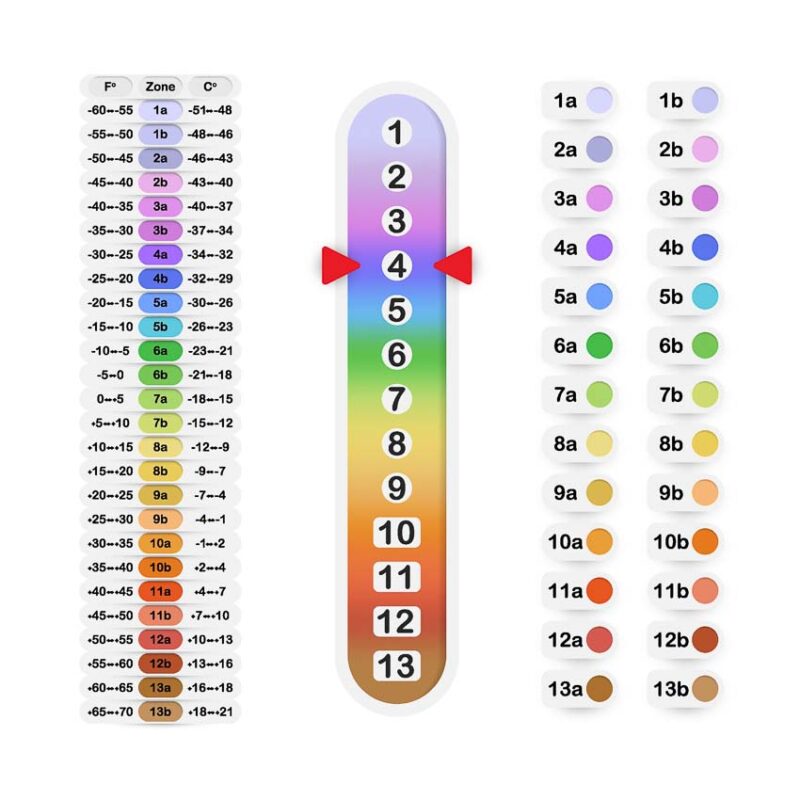
Dutch white clover is cold hardy to USDA hardiness zone 4. It has a harder time surviving hot weather and drought conditions during the summer. In some climates, white clover turns brown in the winter, but in the south, it is grown as a winter annual.
Is Dutch White Clover Edible or Medicinal?
All parts of the white clover plant have culinary uses. The greens are high in protein with a sweet flavor. Furthermore, they are edible raw or cooked. You can use the flowers for tea, and the seeds can be ground into flour.
People have used white clover as medicine for colds and fevers; in India, they use it to expel worms.
Can Dutch White Clover Be Used as a Lawn Substitute?
Dutch white clover was commonly grown with grass until broadleaf herbicides were introduced in the 1950s. You can either grow it with grass or as a substitute. Either way, Dutch white clover requires less frequent mowing, watering, and fertilization, which can lead to significant cost savings and reduce the environmental impact of grass lawns.
How to Control Dutch White Clover Spread?
White clover infestations are most common in poor soils, so fertilizing your lawn is an excellent way to stop its spread. White clover is a nitrogen-fixing plant with a symbiotic relationship with bacteria that lives on its roots, which converts atmospheric nitrogen into a form readily available to plants.

